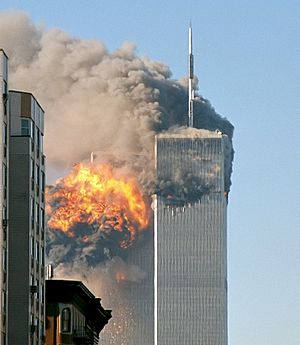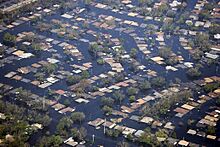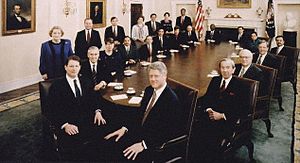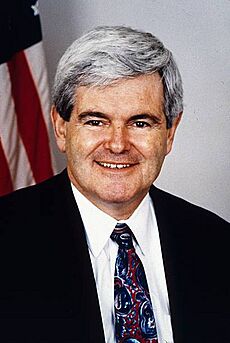History of the United States (1991–2008) facts for kids
| 1991–2008 | |
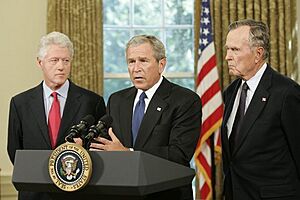
|
|
| Preceded by | History of the United States (1980–1991) |
|---|---|
| Including | Reagan Era War on Terror War on drugs Third Industrial Revolution New Great Migration |
| Followed by | History of the United States (2008–present) |
The history of the United States from 1991 to 2008 covers a time when the Cold War ended. This happened after the dissolution of the Soviet Union in 1991. The U.S. became the world's only superpower, meaning it was the strongest country. The U.S. played a big role in military actions, especially in the Middle East. For example, it helped remove Iraqi forces from Kuwait during the Persian Gulf War.
Back home, the Democrats won the White House in 1992 with Bill Clinton as president. In 1994, the Republicans took control of Congress for the first time in 40 years. This led to some disagreements, including a government shutdown. But later, they worked together on things like welfare reform and the Children's Health Insurance Program. President Clinton was later impeached by the House of Representatives but was found not guilty by the Senate. The U.S. economy grew a lot in the 1990s, especially with new technology. However, this "dot-com bubble" burst, leading to an economic slowdown.
In 2000, George W. Bush became president after a very close election. His government worked on education reform and cut taxes to help the economy. After the September 11 attacks in 2001, the U.S. started the Global War on Terrorism. This included the war in Afghanistan to remove the Taliban and fight Al-Qaeda. In 2003, the U.S. invaded Iraq, which led to a long conflict. The Homeland Security Department was created, and the Patriot Act was passed to fight terrorism at home. In 2006, the Democrats gained control of Congress. This was partly due to problems with the response to Hurricane Katrina in 2005 and the growing unpopularity of the Iraq War.
Contents
The Economy and a Changing World
During Bill Clinton's time as president, the U.S. mainly focused on issues at home. The early 1990s saw a slow economy, but it started to get better around 1994. This was thanks to a big growth spurt caused by new technology.
The Internet and New Technologies
The Internet and related technologies began to be used widely. This led to a big boom in technology companies on Wall Street. By 1998, the economy was doing very well, and many people had jobs.
After the Soviet Union ended in 1991, the United States became the world's strongest military power. Other countries like Japan faced economic problems. Meanwhile, China started to become a major trading partner and competitor for the U.S.
The U.S. also sent troops to places like Haiti and the Balkans to act as peacekeepers. This brought up old discussions about whether the U.S. should be involved in policing other parts of the world. Some groups overseas threatened attacks against the U.S. because of its military presence in the Middle East. They even carried out the first World Trade Center attack in 1993.
Growing Population Changes
Many people moved to the United States during the 1990s, mostly from Latin America and Asia. This started to change the mix of people living in the U.S. For example, Hispanics became the largest minority group. Even after the September 11 attacks led to stricter border checks, nearly 8 million immigrants came to the U.S. from 2000 to 2005.
The Dot-Com Bubble Bursts
The "dot-com bubble" was a period when many new Internet companies were created, and their stock prices went very high. People were very excited about the Internet's future. However, many of these companies did not make money.
In early 2000, this bubble burst. Stock prices for technology companies fell sharply. Many dot-com companies closed down because they ran out of money. This led to an economic slowdown in the early 2000s. Even with this, the economy started to recover in 2003, and more people found jobs.
Major Conflicts and Challenges
The Persian Gulf War
Countries around the world rely a lot on oil, and much of the world's oil comes from the Middle East. This made the region very important to the U.S. In August 1990, Iraq invaded its neighbor, Kuwait. U.S. leaders worried that Iraq might also attack Saudi Arabia, another important oil-rich ally.
The United Nations said Iraq's invasion was wrong. President Bush said that if the world did nothing, other countries might also become aggressive. The UN set a deadline for Iraq to leave Kuwait, but Iraq's leader, Saddam Hussein, ignored it. So, the UN allowed a military response. The war began in January 1991. U.S. troops made up most of the forces in this operation, called Operation Desert Storm. By the end of February, Iraqi troops left Kuwait.
U.S. Involvement in Other Conflicts
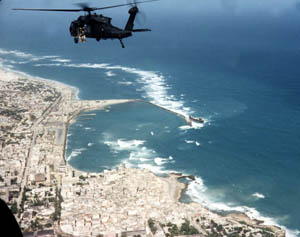
In December 1992, President Bush sent troops to Somalia. This was part of a UN effort to help bring order and aid to the country, which was suffering from civil war and famine. By 1993, the situation became more difficult. After some soldiers were killed, U.S. forces launched an attack in Mogadishu. In October 1993, 18 American soldiers died in the Battle of Mogadishu. After this, President Clinton ordered U.S. troops to leave Somalia.
In the mid-1990s, the U.S. was also involved in the Bosnian War through NATO. NATO's bombing campaign in 1995 helped lead to a peace agreement that ended the war. Later, in 1998, fighting broke out in Kosovo. NATO launched another bombing campaign in 1999, which led to Yugoslavia withdrawing from Kosovo.
President Clinton also ordered missile strikes on Iraq in 1996 and 1998. These were in response to Saddam Hussein not following UN rules. The goal was to weaken Hussein's power.
Throughout the 1990s, the U.S. also tried to help with peace between Israelis and Palestinians. President Clinton, Israeli Prime Minister Yitzhak Rabin, and Palestinian leader Yasser Arafat signed the Oslo Accords in 1993. This agreement aimed for a gradual transfer of control to Palestinians in exchange for peace. However, peace efforts faced challenges.
September 11, 2001, Attacks
On the morning of September 11, 2001, 19 terrorists from al-Qaeda hijacked four airplanes.
- The first plane hit the North Tower of the World Trade Center in New York City.
- A second plane hit the South Tower shortly after. Both 110-story towers later collapsed.
- The third plane crashed into the Pentagon, the U.S. military headquarters, in Virginia.
- The fourth plane, United Airlines Flight 93, crashed in Pennsylvania after passengers fought back against the hijackers. It is believed this plane was headed for the White House or the Capitol.
These attacks killed nearly 3,000 people. It was the deadliest terrorist attack in history and the worst foreign attack on American soil since Pearl Harbor in 1941. The 9/11 attacks made the U.S. focus on a long fight against terrorism, starting with action in Afghanistan.
War in Afghanistan
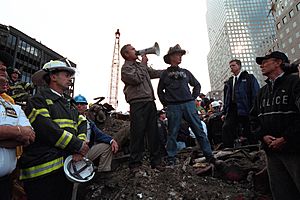
After the 9/11 attacks, Congress allowed President George W. Bush to use military force against those responsible. This led to the invasion of Afghanistan in 2001, as part of the wider Global War on Terrorism. The goal was to remove the Taliban government, which supported al-Qaeda, and capture al-Qaeda leaders like Osama bin Laden.
The invasion began on October 7, 2001, with the help of U.S. allies. The Taliban government was quickly overthrown. By 2002, the U.S. began to focus more on Iraq, moving some resources away from Afghanistan. Afghanistan held its first presidential election in 2004 and parliamentary elections in 2005.
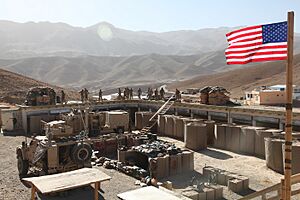
By 2006, more U.S. troops were in Afghanistan. There was increased fighting against the Taliban. Some European allies started to question the war. In 2008, an airstrike killed many civilians, including children, which caused protests and concerns about civilian deaths.
The Iraq War
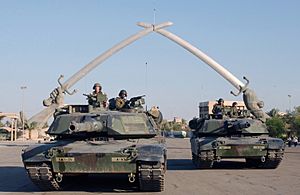
In 2002, President George W. Bush said that Iraq, Iran, and North Korea were an "axis of evil". The Bush administration then argued for invading Iraq. They said Iraq had weapons of mass destruction and supported terrorism.
Some U.S. allies, like France and Germany, did not agree that there was enough proof for an invasion. The UN Security Council did not approve the invasion. However, the U.S., with support from countries like the United Kingdom and Australia, invaded Iraq on March 20, 2003.
After about six weeks of fighting, U.S. forces took control of key areas. Saddam Hussein fled, and his government fell. President Bush declared that major combat operations were over. Saddam Hussein was later captured and executed in 2006. However, fighting continued against an Iraqi insurgency.
The war became very costly in terms of lives and money. Many people in the U.S. lost support for the war. International opinion of the U.S. also became less positive. In 2007, President Bush ordered more troops to Iraq, which helped reduce casualties.
Major Disasters
Natural Disasters Across the U.S.
The U.S. faced several major natural disasters during this period.
- In August 1992, Hurricane Andrew hit South Florida as a very strong storm. It caused huge damage, especially in Miami's suburbs. It was the costliest storm in U.S. history at that time.
- In March 1993, the "Storm of the Century" hit the Eastern U.S. It brought hurricane-force winds, storm surges, and heavy snow, even in the South.
- The Great Flood of 1993 affected the Midwest, especially the Mississippi River and Missouri River valleys. It destroyed many homes and farmlands.
- In January 1994, the Northridge earthquake hit Los Angeles. It was very destructive in the urban area, causing billions in damage.
- In July 1995, Chicago experienced a severe heat wave. Temperatures were extremely high, leading to over 700 deaths. This event highlighted the dangers of heat waves for vulnerable people.
- In January 1996, the Blizzard of 1996 brought heavy snow to the Northeastern U.S., crippling major cities.
- In May 1999, a powerful tornado outbreak struck Oklahoma. An F5 tornado hit Oklahoma City and Moore, causing over $1 billion in damage.
- In 2004, four hurricanes—Charley, Frances, Ivan, and Jeanne—hit Florida within a month. They caused many deaths and billions in damage.
- The 2005 hurricane season was very active. In August 2005, Hurricane Katrina struck the Gulf Coast. It broke the levees in New Orleans, Louisiana, flooding 80% of the city. There was also widespread damage along the Mississippi coastline. At least 1,800 people died. Many people were trapped by floodwaters and needed rescue. The response from local, state, and federal governments was heavily criticized. President Bush promised to help rebuild the damaged areas.
- Weeks after Katrina, Hurricane Rita hit the Texas/Louisiana border, causing the largest evacuation in U.S. history.
- In October 2005, Hurricane Wilma struck Florida, causing more deaths and damage.
- In February 2008, a destructive tornado outbreak hit the Mid-South, killing over 60 people.
- In September 2008, Hurricane Gustav and Hurricane Ike caused significant damage in Louisiana and Texas, leading to high gas prices.
Energy Challenges
After 1970, the U.S. started importing more oil as its own oil fields produced less. Throughout the 1990s, oil prices were relatively low. However, after 2002, oil prices tripled, reaching about $4 a gallon in 2008.
The idea of "energy independence" became important. This meant finding ways for the U.S. to produce its own energy and rely less on other countries. Laws were passed to make cars more fuel-efficient and to encourage better energy use in homes. Many new energy sources, like ethanol, wind power, and solar power, were discussed and funded.
New ways of getting oil and natural gas were discovered in places like North Dakota and Appalachia. However, there were debates about how these methods might affect the environment and water supply. Drilling for oil in the Arctic National Wildlife Refuge (ANWR) was also a big debate.
U.S. Politics and Leadership
The Clinton Administration (1993-2001)
After the First Gulf War, President George H. W. Bush was very popular. However, economic problems and a broken campaign promise hurt his popularity. In 1992, Bill Clinton won the presidential election with 43% of the vote. Independent candidate Ross Perot also ran, getting a record 19% of the vote.
Bill Clinton was 46 when he became president in January 1993, making him one of the youngest presidents. He promised to focus on solving domestic issues in the U.S.
One early success for Clinton was the 1994 Assault Weapons Ban. Clinton also tried to create a national health care system, but this plan did not pass. However, his wife, Hillary Clinton, helped create the Children's Health Insurance Program.
A Republican Congress (1995-2007)
For 40 years, Democrats had largely controlled Congress. But in the 1994 midterm elections, Republicans gained control of both the House and the Senate. House Republicans, led by Newt Gingrich, introduced their "Contract with America" plan.
President Clinton worked with some Republicans, taking a more central approach to politics. For example, he signed welfare reform into law in 1996. This new law required welfare recipients to work and set limits on how long they could receive payments. Clinton also supported strong anti-crime measures.
However, there were still disagreements. The parties could not agree on a budget, which caused the federal government to shut down in late 1995 and early 1996. By the end of Clinton's time in office, the U.S. economy had grown for a long time, and the government had a budget surplus.
In the 1996 election, Clinton won again, defeating Republican Senator Bob Dole. Ross Perot ran again but did not get as much support.
President Clinton was impeached by the House of Representatives, but the Senate did not remove him from office. After this, Speaker Gingrich resigned. In 1999, Dennis Hastert became Speaker of the House.
The George W. Bush Administration (2001-2009)
George W. Bush became president on January 20, 2001, after a very close election in 2000. Early in his term, Bush signed a large tax cut to help the economy. Other laws included the No Child Left Behind Act for education reform in 2002. The economic growth of the 1990s had ended, and the U.S. faced a recession in 2001.
After the September 11 attacks in 2001, President Bush ordered all flights grounded. Congress passed the controversial USA PATRIOT Act to improve security. The Department of Homeland Security was also created to combine many federal agencies dealing with security and emergencies. On October 7, 2001, the U.S. invaded Afghanistan as part of the War on Terrorism.
In 2002, President Bush said Iraq had dangerous weapons and posed a threat. Despite widespread protests and doubts from some allies, the invasion of Iraq began on March 20, 2003. Saddam Hussein was captured later that year.
The economy recovered from the recession, with good growth through the mid-2000s. Unemployment rates also fell.
President George W. Bush was re-elected in November 2004, defeating Senator John Kerry. Republicans also gained more seats in Congress. Bush's popularity later dropped in his second term due to the long Iraq War, the handling of Hurricane Katrina, and a major financial crisis. President Bush was followed by Barack Obama in January 2009.
A Democratic Congress (2007-2009)
Democrats won control of Congress in the 2006 elections. Nancy Pelosi became the first woman to be Speaker of the United States House of Representatives. Democrats proposed a "100-Hour Plan" with goals like reducing the deficit, raising the federal minimum wage, and working for energy independence.
The new Congress had limited influence on the Iraq War. They passed a bill for war funding that included a plan for troops to leave Iraq, but President Bush vetoed it. In 2007, a bill for immigration reform did not pass in the Senate.
See also
- Presidency of George H. W. Bush
- Timeline of United States history
- Timeline of modern American conservatism
- Timeline of the history of the United States (1990–2009)



